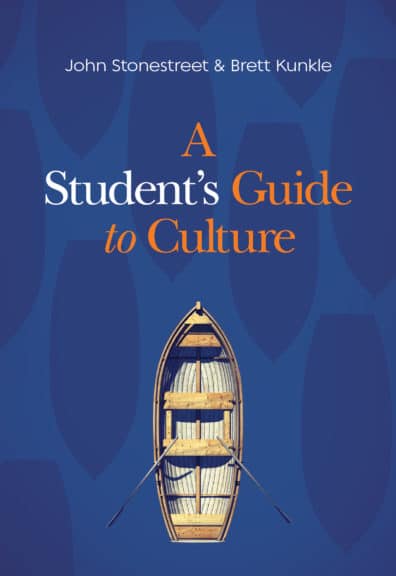Editor’s Note: This article was excerpted from A Student’s Guide to Culture. © 2020 John Stonestreet and Brett Kunkle. Published by David C Cook. All rights reserved.
No, the Bible isn’t a book of rules, or a book of heroes. The Bible is most of all a Story … [and] the best thing about this Story is—it’s true.”
Sally Lloyd-Jones, The Jesus Storybook Bible
Throughout history, most Christians have found themselves in antagonistic cultures. For example, early Christians in the Roman Empire often faced terrible persecution. Followers of Christ lost their lives in a number of horrific ways, including being crucified, lit on fire, or thrown to hungry lions for sport. But that didn’t stop many Christians from living out their faith.
During that time, children, unborn and born, were considered disposable. Abortion was common. Other babies were killed through a practice called exposure. Roman families who didn’t wish to feed additional mouths would abandon newborns in the wild to die. Though exposure was legally and culturally acceptable at the time, Christians quickly embraced a different practice. They rescued these children, adopted them into their families, and raised them in the church.
Their actions were redemptive and praiseworthy, but there’s more to the story.
Because newborn girls were the most common victims of exposure, within a couple of decades a gender imbalance developed in many Roman towns. When Roman men wanted to find wives, it was Christian families who had a great number of eligible young women. Many Roman men converted to Christianity in order to marry. According to sociologist Rodney Stark, this is among the factors that explain the explosive growth of Christianity in the second century.
In the midst of a culture of death, Christians brought life, hope, and redemption, both physically and spiritually.
The Story and the Moment

God is always at work through—and at times even in spite of—His people. He is at work today as well. Everywhere, for those with eyes to see, is evidence of that work. God is using His people to lead nations out of poverty, create brilliant art, tell life-changing stories, adopt orphans, heal the sick, and restore broken lives and cultures.
As Christians, we belong to a larger Story that God has been writing since before the beginning of time. When we allow ourselves to be shaped by His Story, we’ll be better equipped to make a difference in our cultural moment. This is why Scripture is absolutely essential for followers of Jesus.
Christians contend the Bible is true. It’s not just true for us or one truth among many truths, rather the Scriptures are objectively true.
In other words, the Scriptures describe reality as it actually is.
Obviously, many people do not share this view of the Bible. But their unbelief doesn’t change the truth. If you refuse to believe in gravity, will that stop you from falling if you jump out of a two-story building? Of course not. In the same way, the Scriptures are true whether we believe them or not.
The Bible is not merely a collection of nice stories or moral lessons. It doesn’t just tell us how to be “spiritual.” The Bible describes the Big Story of reality. Notice it doesn’t start “once upon a time,” but “in the beginning.” It provides the overarching Story of the world, humanity, and history. God’s Word tells us where everything came from, including us, and where everything is going, including us.
The Larger Story
This point is crucial to rightly understand and approach culture: No matter how chaotic, grave, disturbing, broken, or troubling our cultural moment may be, its full meaning is revealed only in light of the larger Story of which it is a part. We must learn to approach our cultural moment from the Big Story; otherwise, we’ll miss the meaning of both the moment and the Story.
Imagine someone abandoning The Lord of the Rings trilogy because he was angry that [Spoiler alert for this and the next two paragraphs!] Gandalf fell off the bridge as he was fighting the demon-like Balrog near the end of the first book.
“What kind of author kills off such a cool character as Gandalf?” he complains. “I want nothing to do with that kind of story!”
Anyone who’s seen The Lord of the Rings movies or read the books would protest, “Wait! That’s not the whole story. Gandalf doesn’t die. He comes back. And he’s no longer Gandalf the Grey; he’s Gandalf the White. And in the end, he’s part of the good that defeats evil.”
Like our fictional Lord of the Rings reader, we’re also at risk of losing the Story in the heat of the cultural moment, particularly when the world seems to be spinning out of control. Reeling from a tragic school shooting or political scandal, overwhelmed by porn addiction, trying to navigate a world where wrong is right and sin is popular, Christians often become reactionary and approach culture by asking the wrong question first.
“Where Should I Draw the Line?”

Christians often divide the world into sacred and secular, or spiritual and worldly. Everything on the spiritual side is good. Everything on the worldly side is bad. So when they approach culture, their primary concern is to keep from crossing the line from good to bad.
We draw lines like this all the time: all Christian music is good and all secular music is bad. Rated R movies are off limits, so Christians make “faith-based” alternatives. But what about good films that aren’t explicitly Christian? What about historically based films that, though violent, remind us of courageous heroes and defining moments that changed the world? If Tom Cruise is in a movie, is it automatically a promo for Scientology?
Asking, “Where do I draw the line?”—called the line approach to culture—is too simplistic to be helpful.
First, not everything labeled Christian is good, and not everything labeled secular is bad.
Much that is labeled Christian—movies, songs, leaders, schools, churches, ministries, and organizations—fails to reach basic levels of excellence and honesty. And much that is labeled secular accurately portrays fallen humanity, displays artistic genius, and brings good to the world. As Gregory Thornbury, former president of The King’s College, says, “‘Christian’ is the greatest of all possible nouns and lamest of all possible adjectives.” It’s meant to describe a person, not a thing.
Lines in the Right Places
An honest look at Christian history reveals we don’t always draw lines in the right places. Not that long ago, some Christians drew lines between races by segregating Christian schools, condemning interracial marriages, and promoting other ways of keeping apart anyone who looked different than they did. Out-of-context Bible verses were used to prop up this sinful behavior. Mistakes like these prove just how susceptible Christians are to cultural pressure.
Line drawing is a shortsighted reaction to the cultural moment if not solidly grounded in the Christian Story. Of course, many behaviors and beliefs do “cross the line.” The Bible speaks at length about how we should act, speak, and treat people. But that isn’t the right question to ask first.
Starting with the Story
The apostle Peter was one of Jesus’ closest friends. He walked with and learned directly from God’s Son. When Peter wrote his first letter to Christ followers, it came during a difficult cultural moment. He referred to his audience—Christians scattered by a growing persecution—as “exiles.” The persecution of Christ followers would only get worse, and Peter himself was eventually killed for his faith.
To strengthen the church in those trying times, the apostle, who famously denied Jesus, opened his letter not with the growing pressures and dangers of the moment but with a reminder of the gospel Story:
Blessed be the God and Father of our Lord Jesus Christ! According to his great mercy, he has caused us to be born again to a living hope through the resurrection of Jesus Christ from the dead, to an inheritance that is imperishable, undefiled, and unfading, kept in heaven for you, who by God’s power are being guarded through faith for a salvation ready to be revealed in the last time.
(1 Pet. 1:3–5)
Only the good news of God’s True Story of the world would enable Christ followers to endure trials, resist temptation, love their enemies, do good, and live well in the cultural moment. Peter didn’t dwell on persecution or the pervasive immorality of pagan society. He returned again and again to the truth that defined their moment, our moment, and every moment of human history: Christ has risen from the dead! Our hope is secure.
The Bible Is One Big Story
Many Christians view the Scriptures in bits and pieces. Maybe you memorized individual Scripture verses or heard lots of Bible stories in Sunday school. If you just get bits and pieces, though, the Bible can become a disconnected collection of verses and stories designed to teach us how to be moral, happy, and successful.
Such a limited view of Scripture doesn’t give us an accurate—or even exciting—story. A Hindu scholar once challenged the way Christian missionaries presented the Bible to people in India:
I can’t understand why you missionaries present the Bible to us in India as a book of religion. It is not a book of religion—and anyway we have plenty of books of religion in India. We don’t need any more! I find in your Bible a unique interpretation of universal history, the history of the whole of creation and the history of the human race…. That is unique. There is nothing else in the whole religious literature of the world to put alongside it.
What we often miss is that the Bible is a comprehensive narrative. It tells the Story of the world, from the creation to the new creation.
Like all good stories, the biblical story line includes an introduction, a protagonist, antagonists, conflict, and resolution. Yet this Story is different from all other stories because it’s God’s Story. As such, it accurately describes reality, including what has gone wrong and how God will bring history to its final conclusion according to His purposes.
The Bible and Culture

“What does this have to do with culture?” you may be asking.
Everything.
If the Scriptures tell the true Story of the world, then our current cultural moment is part of its story line. The only way to make sense of what’s happening at this moment is by placing it in its true context of God’s bigger Story as recorded in the Bible.
The Bible is one big book made up of sixty-six smaller books and letters that dozens of people authored over thousands of years. Yet its Story, with all of its different characters, plotlines, twists, and turns, fits together and makes total sense. In fact, the Big Story of the Bible can be summarized in four chapters: creation, fall, redemption, and restoration.
Creation
“In the beginning, God created the heavens and the earth” (Gen. 1:1).
That’s how the Story begins. God is the author of the Story. The world we live in belongs to Him, not us. He is in charge. We are not. From the start, the Story established its theology (one God rules absolutely over everything) and its cosmology (the world is not an accident; it is an ordered creation). God, from the very beginning, was interested and engaged in the world He made. His plan was for it to flourish and be filled with life. And after each day of creation, God declared His world was good.
The pinnacle of the Story’s first chapter is the creation of man and woman. God’s plan for the world would be carried out by His image bearers. They were to “be fruitful and multiply and fill the earth and subdue it.” And they were to “have dominion over the fish of the sea and over the birds of the heavens and over every living thing that moves on the earth” (Gen. 1:28). It wasn’t their world; it was God’s world. They were to care for it and cultivate it so that it would become the place God intended it to be. This is the Story’s anthropology. The world God made, and the capacity humans have to make something of the world, were good from the beginning (see verses 18 and 31).
Of course, the next chapter affirms that there is bad in the world. But remember, the Story begins in Genesis 1—not Genesis 3.
Fall
In all good stories, something goes wrong. The big bad wolf gobbles up Grandma. The White Witch turns Narnia into a place where it is always winter but never Christmas. Sauron amasses an army of Orcs, goblins, trolls, bad wizards, and other evil creatures to conquer Middle-earth.
The biblical Story is no different.
When Satan deceives Adam and Eve and they decide to follow their own path—instead of God’s command—sin and death enter the Story. Order was disordered. Our good, God-given capacities were marred by evil acts, broken relationships, and selfish intentions. And we’re part of the problem too. Sin is not just “out there,” as if we’re innocent bystanders. It’s “in here,” in every human heart and mind.
Yet even after sin and death entered the world, God never removed the expectation He had of His image bearers to be image bearers. His created intent that humans “be fruitful and multiply and fill the earth and subdue it” remained (Gen. 1:28). To be sure, the fruitful part is now accomplished only through the pains of childbirth, and thorns frustrate the subduing part. But the command to fill and subdue the earth still stands. God created the world good, as well as our abilities to make something of it. As the apostle Paul told Timothy, God even “richly provides us with everything to enjoy” (1 Tim. 6:17).
All is not lost.
Redemption

Thankfully, the biblical Story doesn’t end after Genesis 2. The majority of the Story, in fact, is dedicated to redemption. God covers Adam and Eve’s nakedness. God saves Noah’s family from the flood, even as He wiped wickedness from the face of the earth. He creates a nation, Israel, to be His people. He preserves Israel despite their sin and rebellion, so that through them, all the nations of the earth would be blessed.
Redemption ultimately culminates in the person and work of Jesus Christ, the Word made flesh. He is light, and He is life (John 1:4). Jesus is, as Paul said, “the last Adam” (1 Cor. 15:45), righteous and obedient, though we are not. He took on the sin of the world, suffered God’s wrath in our place, and ultimately defeated death by rising from the grave. All who embrace Christ are forgiven and become the children of God.
If that’s all Christ accomplished, it would be enough to demand our worship and allegiance. But there’s more. The Story did not end at Christ’s resurrection, or at our redemption. There is a fourth chapter.
Restoration
Christians have long debated the details of how the biblical Story ends. However, the final chapter of the Story is summarized in the words of Christ Himself with a present-tense verb: “Behold, I am making all things new” (Rev. 21:5).
The Story that began with the creation of the heavens and the earth ends with a new beginning. The garden is restored in the midst of God’s city. As the Old Testament prophet Ezekiel promised (Ezek. 37:27), the God who once walked with Adam and Eve will make His home with His people. “He will dwell with them, and they will be his people, and God himself will be with them as their God” (Rev. 21:3). When He makes His home with us, all wrongs will be made right, and all lies will be exposed as untrue.
A Better First Question
In God’s Great Story, we live between redemption and restoration. Thankfully, before His ascension, Jesus offered instructions on how to live in this moment: “A new commandment I give to you,” He said, “that you love one another: just as I have loved you, you also are to love one another” (John 13:34). We’re to be disciples who make other disciples (Matt. 28:18–20). Paul tells children to obey their parents and husbands to love their wives. We should be good citizens, as Peter instructs (1 Pet. 2:13–15). And we’re to wait expectantly for the culmination of the Story, which will occur when Christ returns (Rom. 8:22–24).
There are many more instructions in God’s Word, but two especially deserve our attention here. First, as Peter wrote to the exiles facing their tough cultural moment, we are to be defined by hope (1 Pet. 3:15). This isn’t a squishy, wishful-thinking, things-aren’t-that-bad sort of optimism. The believer’s hope, secured through the resurrection of Jesus Christ, isn’t swayed by fickle feelings; it stands strong against the challenges of our times.
Second, the New Testament employs all kinds of “re-” words to describe life between redemption and restoration: renew, repent, restore, regeneration, reconciliation. Paul offered a mission statement to those who have been made new in Christ: “All this is from God, who through Christ reconciled us to himself and gave us the ministry of reconciliation” (2 Cor. 5:18). Reconciled ones are to be reconcilers.
God’s Story
Through faith, love, hope, and reconciliation, we can live God’s Story in this moment without allowing culture to shape us. Only in the larger context of God’s Story are the challenges we face in today’s culture given proper perspective. That’s why there’s a better first question with which to approach culture than “Where do we draw the line?”
The better question is: “What is our salvation for?”
This article was excerpted from A Student’s Guide to Culture. You can learn more about the book here.
More Articles You May Like
- How Culture Shifts Will Impact Your Children’s Ministry (VIDEO: John Stonestreet)
- Your How-to Guide for Creating a Successful Volunteer Culture

A Student’s Guide to Culture
The student edition of the popular A Practical Guide to Culture by John Stonestreet and Brett Kunkle delivers a hopeful message to readers ages 15–25 who live every day with increasing cultural pressure. These young people struggle to navigate contemporary challenges to their Christian faith and values but will be encouraged to emerge as leaders.
In A Student’s Guide to Culture, Stonestreet and Kunkle write in a highly relational style, sharing insight and experience. Jumping off from the original version, this guide includes all-new discussion questions and stories that remind young readers that they can live differently and be a light in a culture that sometimes feels overwhelming.







